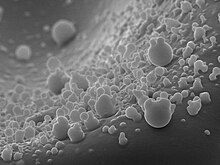
Back كيمياء النانو Arabic Nanokimya Azerbaijani Нанахімія Byelorussian ন্যানোরসায়ন Bengali/Bangla Nanoquímica Spanish نانوشیمی Persian Nanochimie French Nanoquímica Galician नैनो रसायन Hindi Նանոքիմիա Armenian
Nanochemistry is an emerging sub-discipline of the chemical and material sciences that deals with the development of new methods for creating nanoscale materials.[1] The term "nanochemistry" was first used by Ozin in 1992 as 'the uses of chemical synthesis to reproducibly afford nanomaterials from the atom "up", contrary to the nanoengineering and nanophysics approach that operates from the bulk "down"'.[2] Nanochemistry focuses on solid-state chemistry that emphasizes synthesis of building blocks that are dependent on size, surface, shape, and defect properties, rather than the actual production of matter. Atomic and molecular properties mainly deal with the degrees of freedom of atoms in the periodic table. However, nanochemistry introduced other degrees of freedom that controls material's behaviors by transformation into solutions.[3] Nanoscale objects exhibit novel material properties, largely as a consequence of their finite small size. Several chemical modifications on nanometer-scaled structures approve size dependent effects.[2]

Nanochemistry is used in chemical, materials and physical science as well as engineering, biological, and medical applications. Silica, gold, polydimethylsiloxane, cadmium selenide, iron oxide, and carbon are materials that show its transformative power. Nanochemistry can make the most effective contrast agent of MRI out of iron oxide (rust) which can detect cancers and kill them at their initial stages.[4] Silica (glass) can be used to bend or stop lights in their tracks.[5] Developing countries also use silicone to make circuits for the fluids used in pathogen detection.[6] Nano-construct synthesis leads to the self-assembly of the building blocks into functional structures that may be useful for electronic, photonic, medical, or bioanalytical problems. Nanochemical methods can be used to create carbon nanomaterials such as carbon nanotubes, graphene, and fullerenes which have gained attention in recent years due to their remarkable mechanical and electrical properties.[7]
- ^ Bagherzadeh, R.; Gorji, M.; Sorayani Bafgi, M. S.; Saveh-Shemshaki, N. (2017-01-01), Afshari, Mehdi (ed.), "18 - Electrospun conductive nanofibers for electronics", Electrospun Nanofibers, Woodhead Publishing Series in Textiles, Woodhead Publishing, pp. 467–519, doi:10.1016/b978-0-08-100907-9.00018-0, ISBN 978-0-08-100907-9, retrieved 2022-10-28
- ^ a b Ozin, Geoffrey A. (October 1992). "Nanochemistry: Synthesis in diminishing dimensions". Advanced Materials. 4 (10): 612–649. Bibcode:1992AdM.....4..612O. doi:10.1002/adma.19920041003. ISSN 0935-9648.
- ^ Cademartiri, Ludovico; Ozin, Geoffrey (2009). Concepts of Nanochemistry. Germany: Wiley VCH. pp. 4–7. ISBN 978-3527325979.
- ^ Soenen, Stefaan J.; De Cuyper, Marcel; De Smedt, Stefaan C.; Braeckmans, Kevin (2012-01-01), "Investigating the Toxic Effects of Iron Oxide Nanoparticles", in Düzgüneş, Nejat (ed.), Nanomedicine, Methods in Enzymology, vol. 509, Academic Press, pp. 195–224, doi:10.1016/b978-0-12-391858-1.00011-3, hdl:1854/LU-5684429, ISBN 9780123918581, PMID 22568907, retrieved 2022-10-28
- ^ "Nanotechnology | National Geographic Society". education.nationalgeographic.org. Retrieved 2022-10-28.
- ^ Kaittanis, Charalambos; Santra, Santimukul; Perez, J. Manuel (2010-03-18). "Emerging nanotechnology-based strategies for the identification of microbial pathogenesis". Advanced Drug Delivery Reviews. Nanotechnology Solutions for Infectious Diseases in Developing Nations. 62 (4): 408–423. doi:10.1016/j.addr.2009.11.013. ISSN 0169-409X. PMC 2829354. PMID 19914316.
- ^ Gomez-Gualdrón, Diego A.; Burgos, Juan C.; Yu, Jiamei; Balbuena, Perla B. (2011), "Carbon Nanotubes", Progress in Molecular Biology and Translational Science, 104, Elsevier: 175–245, doi:10.1016/b978-0-12-416020-0.00005-x, ISBN 978-0-12-416020-0, PMID 22093220, retrieved 2022-10-28
© MMXXIII Rich X Search. We shall prevail. All rights reserved. Rich X Search